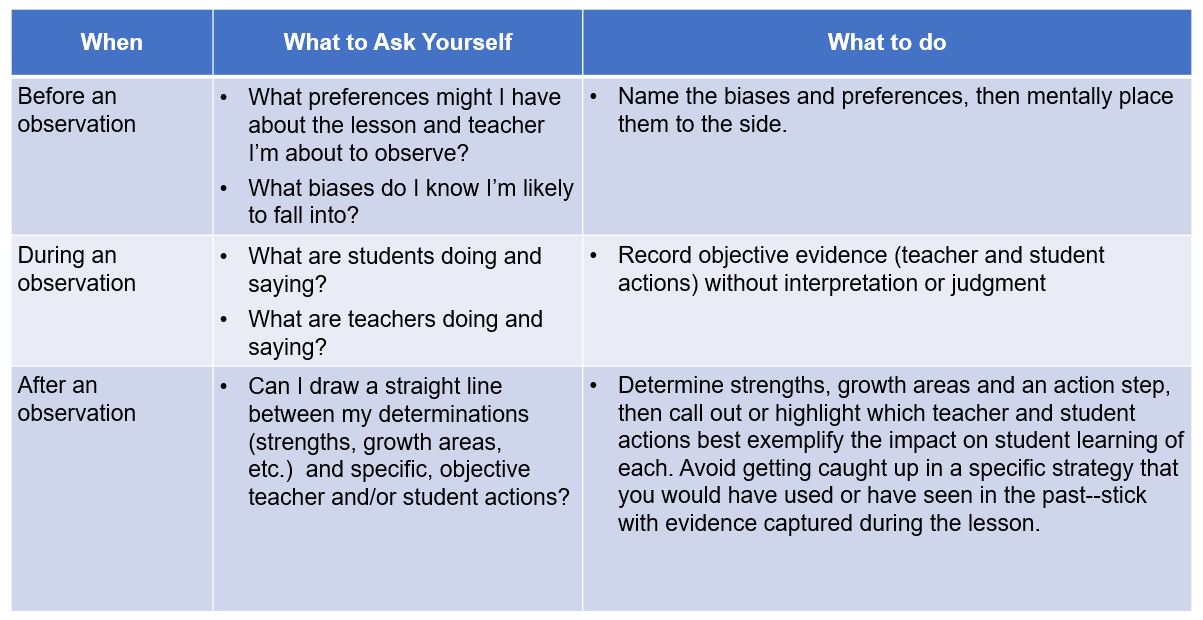Posts Tagged ‘Teacher Development’
Defining and Developing Teaching Excellence: The Hendy Instructional Excellence Rubric
Over the past 12 years, Hendy Avenue Consulting has partnered with numerous school systems to set a vision for excellent teaching, create and pilot instructional rubrics based on this vision, and implement those rubrics to support high-quality teacher coaching and development. These partnerships led to the creation of the Hendy Instructional Excellence Rubric, now freely available under a Creative Commons license on Hendy’s website. Five school systems across the country have already adopted some version of the Hendy Instructional Excellence Rubric. While Hendy tailors each engagement to the specific needs of the school system, Hendy’s close partnership with a large, multi-region charter school network served as the initial catalyst for what is now the Hendy Instructional Excellence Rubric.
The Challenge: The charter school network faced a significant challenge: their four regions were using different rubrics to define and develop excellent teaching. This inconsistency created disparities in how teachers were coached and supported across the network and missed opportunities to use the data to inform network priorities. The network reached out to Hendy to help them lead a project to create, pilot, and implement a unified vision of teaching excellence, aligning teacher development across all regions while maintaining high academic and instructional standards.
Setting the Foundation for Success: Hendy began with careful attention to organizational dynamics and stakeholder buy-in. The charter school network and Hendy established a clear RAPID decision-making framework and identified key stakeholders across departments whose participation would be crucial. This preliminary phase proved essential, establishing both the authority and the limitations within which the team would operate. This also ensured that the rubric development would center on what is most critical for students in classrooms: high-quality teaching and learning.
Creating a Common Vision of Excellence: Hendy convened a diverse subcommittee to lead the project, representing various roles (including talent, curriculum and instruction, and data), schools, tenure levels, and demographic backgrounds. This diverse representation ensured the rubric would be a practical tool for coaching and development. The subcommittee met regularly, engaging in deep discussions about what constitutes excellent teaching facilitated by Hendy team members. The group took a methodical approach to creating the new rubric. They began by discussing what excellent teaching looked like in different contexts and establishing a “blue sky” vision for teacher development. These conversations revealed both the strengths of existing approaches and the opportunities that a unified vision could provide. They conducted a detailed crosswalk of existing frameworks provided by Hendy, identifying the key elements that drove teacher growth across all contexts. This analysis helped the committee work with Hendy to create a rubric that would be both comprehensive and practical for everyday use. The team iterated on the rubric several times, testing different domains and indicators across different classrooms and contexts.
Piloting and Refining the Vision: The pilot phase demonstrated the charter school network’s commitment to thoughtful implementation. Hendy launched the pilot with an orientation webinar, introducing the rubric to the broader community and outlining its purpose, structure, and role in teacher development. This helped build understanding and buy-in. The webinar provided practical guidance for leaders to begin using the rubric while allowing for refinement based on their experiences. Recognizing the unique needs of certain teaching populations, Hendy and the charter team specifically engaged Special Education teachers, fine arts instructors, PE teachers, and preK educators through targeted surveys and focus groups. This ensured their perspectives would shape the final framework. Pilot schools used the rubric in multiple contexts. Leadership teams conducted walkthroughs using the new framework at least 2-3 times that spring, testing its effectiveness in different classroom settings. School leaders also used the framework in coaching conversations with teachers, providing valuable insights. Throughout the pilot, Hendy maintained a strong feedback loop, gathering input through structured surveys and focus groups and used this information to make adjustments. Critically, Hendy and the committee closed the feedback loop by communicating changes back to participants, explicitly connecting their input to specific modifications. Leaders found the rubric helpful in structuring coaching conversations, providing a common language for discussing teaching excellence. They also identified areas where additional guidance was needed, particularly around using the rubric to support different types of teachers and content areas.
Implementation, Training, and Capacity Building: The summer marked the transition to full implementation. In partnership with Hendy, the large, multi-region charter school network invested heavily in developing the capacity of those who would use the rubric. The implementation began with establishing clear systems and structures. Hendy worked with school leaders to determine coaching roles, the frequency of observations and coaching conversations, and how teachers would engage with the rubric. The subsequent training program facilitated by Hendy was comprehensive and sustained, extending through the summer and following school year. It began with foundation training, where coaches learned not just about the rubric’s structure but also how to use it as a tool for development. These interactive sessions included practicing with instructional video analysis and guiding coaching conversations. Quarterly practice-based sessions facilitated by Hendy throughout the school year reinforced learning. Each session followed a thoughtful progression: leaders would study specific indicators, analyze teaching videos, engage in calibration discussions, and practice coaching conversations. The embedded certification process was particularly effective. Rather than a one-time event, it was a supportive process allowing for multiple attempts and providing additional support when needed.
Legacy and Evolution: The Hendy Instructional Excellence Rubric: Hendy’s work on creating and implementing this charter school network’s rubric significantly influenced the development of the Hendy Instructional Excellence Rubric. The Hendy rubric builds upon the successful elements of the charter school network’s process while introducing innovations. Like its predecessor, the Hendy Instructional Excellence Rubric organizes teaching excellence into four domains, each guided by an essential question. It adds “Core Teacher Skills” for each indicator, providing specific, actionable guidance for teacher development. This helps bridge the gap between identifying excellent teaching and developing teachers’ practice. The Hendy rubric also refines the approach to measuring impact, maintaining the charter school network’s focus on student outcomes while creating clearer developmental progressions. This helps teachers and coaches identify specific next steps for growth.
Want to learn more about the Hendy Instructional Excellence framework? Visit our website or email Jessica Wilson!
Unlocking Excellence in Teaching with the Hendy Instructional Excellence Rubric
At Hendy Avenue Consulting, we believe every child deserves excellent instruction, every day, in every classroom. This foundational belief has guided our work with schools and districts across the country for over a decade. Now, we’re thrilled to share a tool that embodies this commitment: the Instructional Excellence Rubric.
This free, equity-focused tool is designed to provide a clear and actionable vision for teaching and learning. With its detailed structure and emphasis on both teacher actions and student outcomes, the rubric is more than a framework—it’s a roadmap for achieving excellence in classrooms.
At Hendy, we have had the privilege of partnering with school systems across the country as they endeavor to implement observation rubrics that support great coaching and development for teachers, and improved outcomes for students. The Hendy Instructional Excellence Rubric is the product of several engagements over several years. With our partners, we saw the need for a higher quality observation rubric that better met school systems’ needs, and we worked to create this rubric in partnership with teachers and school leaders from across the country. We’ve supported several systems to successfully implement versions of this rubric, and have seen the positive impact it has had on schools. We are excited now to make this rubric available, for free, to everyone for the benefit of schools, teachers, and students.
What Makes the Instructional Excellence Rubric Unique?
The Instructional Excellence Rubric stands apart because it balances rigorous academics with social-emotional learning, ensuring that all aspects of a student’s success are prioritized. It reflects years of experience working directly with teachers, leaders, and schools to define what truly works in classrooms.
Here’s how the rubric is structured:
- Classroom Culture: Focuses on creating a predictable, joyful, and equitable environment that maximizes learning time.
- Lesson Content & Implementation: Emphasizes rigorous, purposeful, and differentiated instruction to meet the needs of all students.
- Student Thinking: Highlights the importance of students doing the thinking, speaking, writing, and creating during lessons.
- Responsiveness to Learning: Centers on using feedback and data to adapt teaching and ensure every student grows and succeeds.
Each domain contains clear indicators of excellence, articulated across four levels of performance. These descriptors help educators identify what success looks like and provide actionable steps for improvement.
How Can the Rubric Help You?
Whether you’re a school leader, instructional coach, or system administrator, the rubric can:
- Provide a shared language for excellence across your school or district.
- Guide teacher coaching and development with clear, equity-focused expectations.
- Support classroom observations that prioritize student outcomes.
It’s a comprehensive tool for anyone committed to improving teaching and learning at scale.
The Power of Training and Support
While the rubric is designed to be intuitive and easy to use, its full potential is unlocked through thoughtful implementation and training. That’s where Hendy Avenue Consulting can help.
We offer tailored training and support packages to ensure schools and systems:
- Norm around expectations: Build consistency in how the rubric is used across classrooms.
- Develop coaching capacity: Equip leaders to use the rubric as a tool for meaningful teacher development.
- Customize for your context: Adapt the rubric to align with the unique needs and goals of your school or district.
Our team has a proven track record of helping educators implement tools like this successfully, driving real change in teaching and learning.
Ready to Get Started?
The Instructional Excellence Rubric is available for free download:
Let us help you bring it to life. Reach out to Jess to schedule a call!
Together, we can ensure every child experiences the excellent instruction they deserve.
Collaborating to Examine Teacher Observation Rubrics for Equity
As an organization that strives to be anti-racist and to advance diversity, equity, inclusion and justice in our work, our Hendy team has taken a close look at our priorities and projects to determine how we can take steps to actively help create anti-racist schools. We believe that every organization should consider where they have influence and take strides to use their influence to proactively address racism, and teacher evaluation rubrics is ours.
As experts in teacher evaluation, and as an organization that frequently supports networks, districts and states to design and implement teacher evaluation rubrics, we identified rubrics as a place that we can advance equity with our clients. We know a lot about rubrics, both about how to write good rubrics, and how to implement rubrics to support teacher development and growth. And, we’ve been intentional about including language about inclusion and diversity in rubrics that we’ve helped to draft and implement. But we hadn’t yet taken an intentional look at rubrics to identify what in the language may be truly advancing equity in teaching and learning, and what might be hindering equity. We also knew that, as a team of four people who all identify as white, we have some critical blindspots in the work of examining tools with an anti-racist lens.
So, before we set out to create a tool, host a workshop, or even publish this blog post, we decided to do the work of examining rubrics ourselves. We contracted with two trusted leaders in Diversity, Equity, and Inclusion (DEI) in education, Carrie Ellis from Celestial Consulting and Ashley Griffin from Bowie State University and BEE Consulting, who themselves are women of color, and asked them to engage in this work with us. We also engaged Talia Shaull from Achievement First and Lisa Friscia from Democracy Prep, both members of Hendy’s Chief Talent Officer cohort, so we could have the perspective of practitioners in the field leading this work in their organizations. As a team we set out to examine the language of four teacher observation rubrics, two that are commonly used in districts and networks across the country, and two that are specific to networks we work closely with. Our intent was to identify specific examples of language, and overall trends in rubrics, that either supported or hindered efforts to advance equity and anti-racism. We also wanted to test a potentially transferable process for examining rubrics with an anti-racism lens.
We started the work by first affirming the role of rubrics in advancing equity and anti-racism in schools, and were honest about what rubrics can and can’t do. Then we examined the content of four rubrics to identify:
- Language or expectations in the rubric that values white dominant norms, values, and culture over those of other racial groups;
- Language in the rubric that is supportive of equity (specific practices, mindset cues for teachers, etc.); and
- Missed opportunities in the rubric to advance equity of instruction for students.
We organized and summarized the themes we saw in each rubric, and discussed those themes together to both align and clarify. In our discussion we surfaced several categories of content that might drive examination of other rubrics for bias and equity.
In addition to categories of content, we also discussed structural features of rubrics, and how those features may or may not advance equity. Specifically, we discussed student-focused vs. teacher-focused rubrics, and the inclusion of DEI as a separate indicator vs. baked in throughout all indicators.
Bringing together experts in different content areas to wrestle with a challenging question was engaging and frankly a lot of fun. We were able to push each other’s ideas, discuss what really matters, debate language and its impact, and learn and grow in the process. At the end of the day, our brains were tired, but we were energized by the ideas we created together and the possibility of sharing with others. We see a significant opportunity to improve rubrics and recognize that while doing so is insufficient for creating anti-racist schools, they do play a critical role in driving teacher practice and leaders’ coaching, and therefore must be improved.
Our work helped us to develop guidance that might support others who wish to examine their own teacher observation rubric, and inspired us to engage others in this work. We look forward to sharing that guidance in a webinar later this spring. If you or your team would like to engage in this work, please reach out. We all have a role to play in advancing anti-racism in our schools, and teacher evaluation rubrics can be a great place to start or continue efforts to ensure equity for all students.
Huge THANK YOU to Carrie, Ashley, Talia, and Lisa from all of the Hendy team!
Hendy Webinar Aug 5: Is your teacher evaluation system ready for Covid-19?
Ensuring that teachers feel safe, valued, and supported is at the heart of successfully reopening schools this fall. Development and evaluation systems can play a big role in defining the teacher’s experience and should be thoughtfully re-designed and communicated to meet those goals. The Hendy Avenue Consulting team has partnered with districts, states and CMOs to identify solutions to the tough questions around how to best develop and evaluate teachers in a remote or hybrid environment in a way that is consistent, fair, and supports teacher growth. We look forward to meeting with you and other system leaders to discuss the challenges, opportunities presented, and possible solutions for effectively supporting and evaluating teachers this year.
Please Join Us: Wednesday, August 5th at 4:00pm EST
REGISTER HERE!
Re-Thinking Teacher Development and Evaluation in 20-21: Facilitated by Hendy Avenue Consulting’s Jeremy Abarno and Sarah Rosskamm, please join other system leaders to learn how to approach teacher evaluation and development in a hybrid or remote environment and to connect with other system leaders in small group conversations and resource sharing.
Don’t You Want to Stay? Virtual Stay Conversations as Key Teacher Retention Strategy
Teacher and staff retention is a common concern we hear from school leaders in “normal” times. One of the most efficient and lowest cost methods we have found for encouraging great teachers to stay is by holding “stay conversations”. A stay conversation is an informal chance to share how much you appreciate a teacher’s work, and to directly ask them to stay at your school for the following school year. Stay conversations don’t take much effort, but they have a big impact. When teachers were asked why they left their school, a common response was simply that no one asked them to stay.*
A stay conversation usually happens in a regularly scheduled one-on-one meeting with the teacher. Stay conversations should begin early in the year, ideally before winter break. Leaders can and should continue to communicate value and priority to teachers throughout the spring. This way, if teachers are presented with an opportunity to leave their school, they know how much they are valued and are less likely to leave.
That’s how stay conversations might proceed in normal times. These, however, are not “normal” times. The challenge and uncertainty of the pandemic makes retaining teachers even more critical. Just because we are all working virtually, leaders should not stop holding stay conversations. In fact, the best practices for stay conversations still apply: keep the conversation brief, affirm how much you value the teacher, and articulate how important they are to your students and school. Be honest about the challenges of remote teaching and uncertainty of what the fall might look like. Then share why the teacher is an important part of the team, especially in this uncertainty. Strong teachers are providing a lifeline to families and students right now, and they will continue to need your great teachers when school restarts in the fall. Finally, ask the teacher directly to stay at your school next year.
Ideally you are touching base with each teacher individually on a regular basis during this time of remote teaching and learning. These one-on-ones can be quick check-ins to ask the teacher how things are going for them, and how you can support them. And they are a great time to say directly how much you value the teacher’s work, and ask them to stay next fall.
P.S. If you need a soundtrack to your stay conversations, try this pop, or R&B, or classic rock, or country, or early 90s style (my personal favorite)!
-Jessica
*From The Irreplaceables, TNTP, 2012.
Celebrating Teacher Appreciation Week 2020
Early May is one of our favorite times of the year. The weather warms, flowers bloom, and teachers are celebrated for an entire week! While we think teachers (and leaders) should be recognized everyday for their tremendous work, Teacher Appreciation Week, this year from May 4 – May 8, is a nice formal opportunity to say thank you.
Though we are teaching, learning, and working virtually, here are 7 ideas for celebrating teachers:
- Send a personal note. More than ever, teachers are inundated with emails and texts. A personal note – sent via the old fashioned, but dependable USPS – can go far for anyone, including your teachers.
- Give a gift. Sometimes, someone taking care of the dinner that night is all you need to make it peacefully to tomorrow. Gift cards, meals from local restaurants, and gift certificates to local businesses are always appreciated. Even a small plant left on the teacher’s doorstep to “decorate their home office” is a meaningful way to say thanks.
- Give time. For leaders, consider cancelling a regular staff meeting and encouraging teachers to use the “found time” to do something for themselves.
- Get families to engage. Ask families to record a short video clip, write notes of appreciation or text pictures of homemade thank you cards.
- Party in a box. Put together a small package of party supplies–balloons, sunglasses, streamers, candy, and a small gift or two–and mail it to each teacher with a label on the outside directing them not to open until a certain date and time. During a staff meeting, have everyone open their boxes simultaneously and start the party!
- Opportunities for input. For some, the greatest recognition is the opportunity to be heard and enhance their impact. Think of ways to bring teachers into decisions–about curriculum, schedules, virtual learning and more.
- Shout-outs. While you may not be physically together, shouting out teachers in meetings, emails, and on social media/websites is a simple, but effective method for letting folks know you value and appreciate them, and a great way to highlight the values you most want your team to exemplify.
Three Lessons for Meaningful Performance Management Incentives
We’re big fans of performance management. We know that for people to achieve their best, they need clear definitions of excellence, resources and tools to achieve that benchmark, and frequent, action-oriented feedback that drives their development. Too often, however, organizations don’t know how to link performance management efforts with valuable incentives for their talent.
Before we dig in, let’s get one thing out of the way: incentives in the workplace are not inherently good or bad. Done well, incentives can be a powerful tool for motivation, recognition and reward. Done poorly, incentives can lead people to feel controlled or set up for failure.
Incentives come in all shapes and sizes but most fit within one of the five Rs:
- Rewards: salary, incentives, bonuses, benefits
- Responsibilities: variety, autonomy, challenge, promotions, learning
- Relationships: coworkers, supervisors, clients, and customers
- Reputations: image, respect, appreciation, feedback
- Rest & Relation: hours, scheduling, flexible, travel, location
So what now? Maybe you want to give a bonus to high-performers, grant newcomers more autonomy or show appreciation to employees who routinely go above and beyond. In any situation, here are three recommendations to help you build a foundation for offering incentives:
- Set achievable, meaningful, and controllable benchmarks for employees. Ambitious goals are great but they should not be impossible to reach. Similarly, desired outcomes must matter to the person and organization. If mission driven, make clear the connection between the individual’s impact and how it helps the the organization get closer to their vision. It may seem obvious, but people also have to know that what they will be measured against can be reached by the levers within their control. We would never evaluate a bank teller by the number of light bulbs that need to be changed monthly, so test your goals to ensure a direct line back to employee actions and responsibilities.
- Know what people want. A huge problem is that organizations generally don’t know what their people want. For example, leaders may assume everyone is motivated by the same things or rely too heavily on what has historically been motivating. Particularly in large or longstanding organizations, there is too much application of the golden rule (treat others as you want to be treated) by decision-makers and not enough of the platinum rule (treat others as they want to be treated). There’s no secret to fixing this problem; you need to do your research (e.g., ask employees, read research on generational shifts, talk to industry leaders) and pilot before full-scale launch. The best approaches customize incentives for specific groups or individuals.
- Keep support and growth at the center. Earning an incentive should not be the end of the journey for your employees. Milestones are important, but should always be coupled with a “what’s next?” conversation so that people feel you are genuinely invested in their growth and development (which we hope you are!) and can tangibly see the road ahead. If one does not yet exist, take the opportunity to co-create. A common pitfall is focusing too much on monetary or extrinsic rewards, sometimes to the detriment of strong intrinsic motivators. Focusing on continual improvement and long-term development will help mitigate this risk.
How have you effectively implemented incentives? What’s been the most interesting outcome? Sound off in the comments below!
Listen Up: Hendy Avenue on EdPOP Podcast
Curious to learn more about Hendy Avenue Consulting? Our very own Jessica Wilson sat down with the host of EdPOP to talk about our mission, recent projects and how talent strategy can make the difference for kids across the country.
Three Steps to Avoid Common Observation Biases
We all have biases. Whether picking an ice cream flavor or choosing to take the scenic route rather than the highway, we all operate with mental models that place disproportionate weight on certain factors that move our judgment in favor of one option when compared to another.
When observing and evaluating teacher practice, there are numerous opportunities for biases to creep in. Just think of all the factors that go into a lesson: the subject, grade, school, teacher, time of day, lesson structure, materials used and more. An observer may think to themselves, “the students were well-behaved for the first class right after lunch”. A different person observing that same lesson may think, “if I was teaching this class, I would have used a different text.” Both of these sentiments may be true, but they have to be placed aside before conducting a visit so that observers can focus on objective teacher and student actions.
In short, great observers, coaches, and evaluators must identify, then set aside, biases in order to fairly and accurately evaluate and develop teacher practice.
Common biases include:
- Confirmation bias: the tendency to search for or interpret information in a way that confirms one’s preconceptions,
- Halo effect: the tendency for a person’s positive or negative traits to “spill over” from one area of their personality to another in others’ perceptions of them, and
- Mirror bias: the tendency to judge performance as “good” if it is “like I would have done it.
A full table of common observer biases with examples can be found here: Observer Bias Examples
In order to mitigate the impact of these biases, great observers should ask themselves three questions:

Round 2: Looking Back, Looking Ahead
In our last post, Looking Back, Looking Ahead: Lessons Learned and What’s to Come in 2018-19, our founder Sarah shared insights on the difficulty of leading change and the excitement around re-engaging with one of our first partners.
This week, we hear from Grant:
What I learned: Historian and philosopher Will Durant said, “we are what we repeatedly do. Excellence, then, is not an act, but a habit.” Durant’s much-quoted line rings true in most endeavors, especially in efforts to drive change. Over the past year, we’ve seen the power of habitual communication–to teachers, school leaders, regional administrators–in sharing consistent messages, building shared understanding and demonstrating competence. Nothing derails stakeholder buy-in more than mixed messages or a lack of information! Habitual communication requires consistent content, format, and tone through a single channel at a regular, expected frequency. In Houston, we’ve supported KIPP in the development of a weekly message to School Leaders around implementation of Teacher Pathways. Each Friday, leaders know they will receive updates, shout outs, resources, and reminders to guide the week ahead. In Delaware, we’ve launched a monthly newsletter for district leaders on DPAS_II, the state’s teacher evaluation system, with a consistent agenda including deadlines and professional development opportunities. These habitual communications do more than provide information, they demonstrate competence and care for colleagues and trust between stakeholders. As you think about the programs you’re leading, consider how you can habitualize communication as a repeatedly do.
What I’m excited about: In 2014, KIPP Texas – Austin began a comprehensive effort to reshape teacher effectiveness and retention through the development of a Teacher Career Pathway. Knowing that great teachers drive student achievement, Austin’s Teacher Career Pathway develops, recognizes and rewards excellent educators so they will get better and stay longer. This fall, the first cohort of Distinguished Teachers will be announced; a group of accomplished educators who have demonstrated consistent gap-closing results for kids, impeccable teaching practice and exemplary professional contributions to the school community. We cannot wait to celebrate these remarkable educators!









